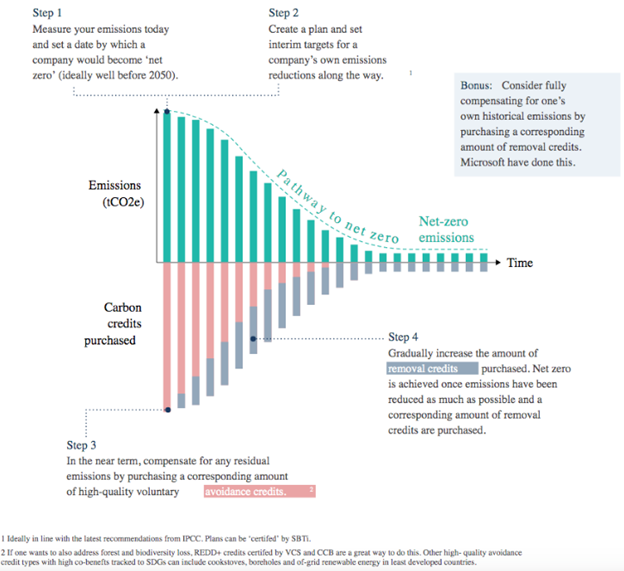Increasingly more companies are setting emissions targets and goals as many industries work towards transitioning to net zero by 2050. Voluntary carbon markets will have a significant role to play in emissions reductions in the coming years and KraneShares took a recent look at last year’s performance and the 2023 outlook on their Climate Market Now blog.
Trove Research, an analytic, data, and advisory firm focused on the carbon markets and climate policy, recently held a webinar to discuss the primary voluntary carbon credits (VCC) markets in 2022.
Demand for voluntary carbon credits continues to grow: last year the total number of companies setting Science Based Target Initiative-endorsed emission reduction goals hit a new high of 4,253. Companies across all industries are committing to emissions reductions, including blue-chip companies like Sony, DHL, Lufthansa, Cemex, and Delta Airlines.

Image source: World Economic Forum
Carbon offset supply fell 14% last year, primarily because of a moratorium placed on credit sales from Honduras, Indonesia, and Papua New Guinea. In previous years, these countries have been large suppliers of offsets for REDD+, a framework created by the UNFCCC Conference of Parties that oversees projects and sustainability related to the forest sector.
“Nonetheless, around 40% of last year’s total supply was for offsets generated by nature-based solutions such as REDD+ and nature restoration, while renewable energy offsets made up a similar share. These offset types correspond broadly to the N-GEO and GEO derivative contracts operated by exchanges CBL and CME,” KraneShares explained.
A total of 173 million tons of carbon credits were retired last year, 2% over the previous year, with renewable energy accounting for nearly half of all offsets retired. Permanent removals and those related to tech were among the fastest growing sectors of credits in 2022, which included technologies like direct air capture, mineralization, and biochar (biomass charcoal) that’s created from decomposing organic materials (wood and agricultural wastes) at high temperatures.
“Critically, the volume of potential future offsets from projects that have not yet been approved more than doubled last year, from 200 million to 529 million tonnes,” KraneShares wrote, indicating that there is increasing investment in carbon offset projects.
2023 Outlook and Investing in the Voluntary Carbon Market
Trove estimates that the primary market for VCCs could grow to reach nearly $2 billion this year, with an anticipated margin between $1.3 billion and $1.9 billion. It’s a wide margin but VCCs are still a relatively nascent industry with much volatility in addition to the global economic impacts of inflation likely to have an impact on demand in 2023.
That said, prices are anticipated to rise 25% with the number of VCCs retired growing by 15%. A carbon offset is retired from the voluntary market once purchased to prevent double counting as well as to ensure the purchaser is the only one that retains the benefits of the offset. It’s a mechanism that works to ensure integrity across the system as well as confidence.
The KraneShares Global Carbon Offset Strategy ETF (KSET) is the first U.S.-listed ETF that offers investors carbon offset investing opportunities and exposure to the voluntary carbon markets. It tracks the S&P GSCI Voluntary Carbon Liquidity Weighted Index, which also offers a first-of-its-kind benchmark for the global voluntary carbon futures market performance that trades through the CME group.
The fund is structured to offer global coverage of voluntary carbon markets by tracking carbon offset futures contracts comprised of nature-based global emissions offsets (N-GEOs) as well as global emissions offsets (GEOs) that trade via the CME group.
As the voluntary carbon markets are a dynamic space, the index is structured in a way that will allow flexibility in re-weighting the securities it tracks. It will also move securities in and out of the index regularly, and it only tracks carbon offset credit futures that have a maturity within the next two years. The index weights the offset futures it tracks by the total value of their traded volume over the last six months.
KSET carries an expense ratio of 0.79%.
For more news, information, and analysis, visit the Climate Insights Channel.

